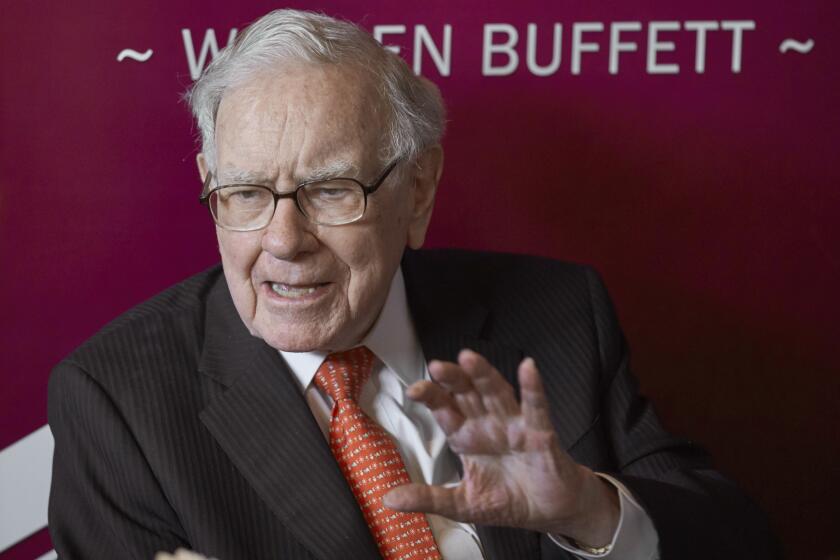Toy-making is serious business in Southern California
- Share via
When a toy designer’s young daughter becomes fascinated by the gel-like beads in a flower vase, there is only one conclusion to draw: “There has got to be a toy in here somewhere,” says Ron Brawer, a partner in the Maya Group and a toy industry veteran.
The fast-growing Torrance company has gone on to develop dozens of playthings based on those transparent polymer pellets. One of those toys, a modified water gun called the Xploderz XBlaster 200, was a finalist for the 2012 Outdoor Toy of the Year Award from the Toy Industry Assn. in New York.
The toy industry is an important segment of the Southern California economy. It accounts for 9,500 jobs in Los Angeles and Orange counties; 276 businesses contribute more than $53 million in annual taxes, according to the Los Angeles County Economic Development Corp.
Nationwide, toys racked up $21 billion in sales last year, much of them designed domestically, according to estimates from the research firm NPD Group Inc. for the Toy Industry Assn. About $2.1 billion of that was manufactured in the U.S.
Toy design in Southern California is rivaled only by New York, and the region is home to some of the world’s best-known brands.
There’s Mattel Inc. in El Segundo (the maker of Barbie and Hot Wheels), Jakks Pacific Inc. in Malibu (licensee of Pokemon and Hello Kitty) and Imperial Toy of North Hills, which produces licensed products for brands such as “SpongeBob SquarePants” and “Transformers.” There’s also MGA Entertainment Inc. in Van Nuys (Bratz dolls) and Jada Toys Inc. in the City of Industry (Tonka and My Little Pony) among many others.
“This is the mecca of toy development,” said Brawer, the creative force behind the Maya Group’s marketing and sales. “It’s the 405 Toy Corridor. Between Irvine and Van Nuys, eight of the world’s biggest toy companies are either located there or have offices there.”
Toy design “is huge here,” said Peter Wachtel, president of the Toy Assn. of Southern California, who estimates that the region’s toy industry directly or indirectly employs as many as 20,000 workers.
“Southern California and New York are the hot spots,” said Wachtel, who said that companies are drawn to the Southland by several factors, including the region’s huge warehouse and distribution system.
Wachtel pointed out that the area is home to the nation’s two biggest container seaports, Los Angeles and Long Beach; is served by the nation’s two biggest transcontinental rail systems, Union Pacific and BNSF; and has two important freight airports, LAX and Ontario. The remnants of the region’s aerospace industry also have been a source of design expertise.
“These are huge pluses,” Wachtel said. “And when the East Coast has gone to sleep, Los Angeles is still up and working.”
Another factor is an abundance of local talent, said Isaac Larian, chief executive of MGA Entertainment.
“A lot of people, especially creative people, just want to live here,” Larian said. “We find most of the people we need right here. We hardly ever hire a designer from outside of the state.”
Charles Woo, chief executive of Megatoys of Commerce, said Hollywood and the entertainment industry draw talent too.
“That creativity is important to have around,” Woo said. “There are a lot of factories in China, but not a lot of that kind of creativity. If I put an ad out for toy designers, I will hear from hundreds of local people.”
One analyst said the region’s schools are key in developing that talent.
“You have some of the best design programs in the U.S. here,” said Edward Woo, senior research analyst who follows the toy industry for Ascendiant Capital Markets in Irvine and is not related to Charles Woo.
And among those schools, the one that is mentioned most is the Otis College of Art and Design in Los Angeles.
Seventy-five of Otis’ approximately 1,800 students are in its toy design department, about 15 students more than usual, said Deborah Ryan, who chairs the toy design program.
“We get a different kind of student,” Ryan said, “because the young people who come here know this is an intensive program. They tend to be very mature and focused.”
Otis has become a virtual employment engine for the toy community. Among the 18 members of the toy design program’s class of 2012, the only two who haven’t found work aren’t even looking yet, Ryan said. The others have found jobs with Mattel, Spin Master Ltd., Hasbro Inc., Imperial Toys, Jakks Pacific, Jada Toys and Razer USA Ltd., and in movie and set design.
The Maya Group story figures prominently in the Southern California toy landscape for a lot of these reasons.
Brawer was pulled into the Southern California orbit from New Jersey when Mattel acquired the company he worked for, Tyco Toys Inc., in 1996.
For the next 13 years, he honed his skills at Mattel and MGA Entertainment. For the latter, he helped grow the Bratz brand into one of the bestselling toy lines. Brawer then spent two years in London as president of the company’s European operations.
It was in London that Brawer and his wife, Sharon Cohen, stumbled on the genesis of their next venture when their daughter Maya couldn’t stop fiddling with some soft, slightly moist polymer beads sitting in a vase.
Soon after, the family returned home to Manhattan Beach, and the couple joined a company coincidentally named the Maya Group, which sold radio-controlled toys. It was owned by Oded Ben-Ezer, who had named it after his own daughter and remains a partner in the company.
When she heard about the origins of Maya Group’s name, Cohen knew she and her husband were on the right track.
“This was just meant to be,” said Cohen, marketing director for the Maya Group.
But after years working for companies with unlimited resources, they started in 2009 at rock bottom and in the economic disarray created by the worst global recession in recent memory.
“We started out of our garage,” Brawer recalled with a laugh. Cohen said that everything they needed to start was in their neighborhood.
“Our house was an office and workshop. The living room became a showroom. The dining room was the meeting room. Dinner conversation was business conversation,” Cohen recalled. “One neighbor shot our product photography. One became our patent lawyer. A couple volunteered to run our focus groups. We did research in the local school and recreation program. It was all-consuming, stressful and exciting.”
The super-absorbent polymer that their products were built around had been developed in the 1960s. When placed in water, the tiny pellets expand to as much as 300 times their size and retain the water for weeks. They had been used by farmers during droughts, by the flower industry and in disposable diapers.
One set of products would use the Orbeez brand name and focus on the fun of growing the beads, turning them into lights, decorations and other things.
“Through my contacts within the industry over the years, we were able to get a few of those products on store shelves in Target and Toys R Us,” Brawer said. “But what we really needed to do was make a commercial. That was a very risky thing.”
It was risky because most small companies simply can’t afford television advertising at that stage.
“It costs $100,000 to produce. On top of that, you need to spend $1 million to air it,” Brawer said. “So you are in for more than $1.1 million, and we had nowhere near the products to cover that.”
But the commercial that aired on Nickelodeon and the Cartoon Network catapulted the company, Brawer said.
The Maya Group now has 20 employees. Sales have grown from about $5 million in 2009 to nearly $100 million this year, Brawer said.
The Orbeez line included a toy ladybug that poops the beads, which can then be vacuumed up.
Another popular toy is a toy foot spa for girls, allowing them to duplicate what they have seen their mothers enjoy with regular ones.
For the boys, the response was nearly universal: “‘These are paintballs,’ they would say. ‘We want to shoot them,’” Brawer said.
Brawer said the beads were perfect from a physics standpoint, able to withstand the initial force that a projectile must take without shattering or fracturing, and able to be fired more than 100 feet, hitting an opposing player without causing injury or pain.
Still, quite a lot of physics and engineering were needed to create an ammunition case that would accommodate the moist “shells” but that could not be used to fire more lethal objects, such as small rocks or metal ball bearings.
For that project, the company turned to Keith Meggs, who had worked at Mattel for 26 years before retiring in 2009.
Meggs joined the Maya Group with the intention of using his design background there for no more than a couple of weeks. Instead, he stayed and is now a partner in the Maya Group.
The company continues to hone its products, including recent brands called Color Splasherz and BlasterPro.
It seems a long way from a small girl’s odd fascination.
“We are a top 20 toy company,” Cohen said. “The chairman of Toys R Us walks through our showroom every year now. He’s a big fan.”
More to Read
Inside the business of entertainment
The Wide Shot brings you news, analysis and insights on everything from streaming wars to production — and what it all means for the future.
You may occasionally receive promotional content from the Los Angeles Times.











